Understanding the Mental Health Concerns of Tabitha: A Case Study
VerifiedAdded on 2023/04/04
|11
|2612
|407
AI Summary
This assignment focuses on the case study of Tabitha, a 16-year-old girl showing unnatural behavior after a school trip. It analyzes her health concerns, factors affecting her behavior, and the psycho-physiological aspects of her health. The assignment also suggests health promotion strategies for her comprehensive well-being.
Contribute Materials
Your contribution can guide someone’s learning journey. Share your
documents today.
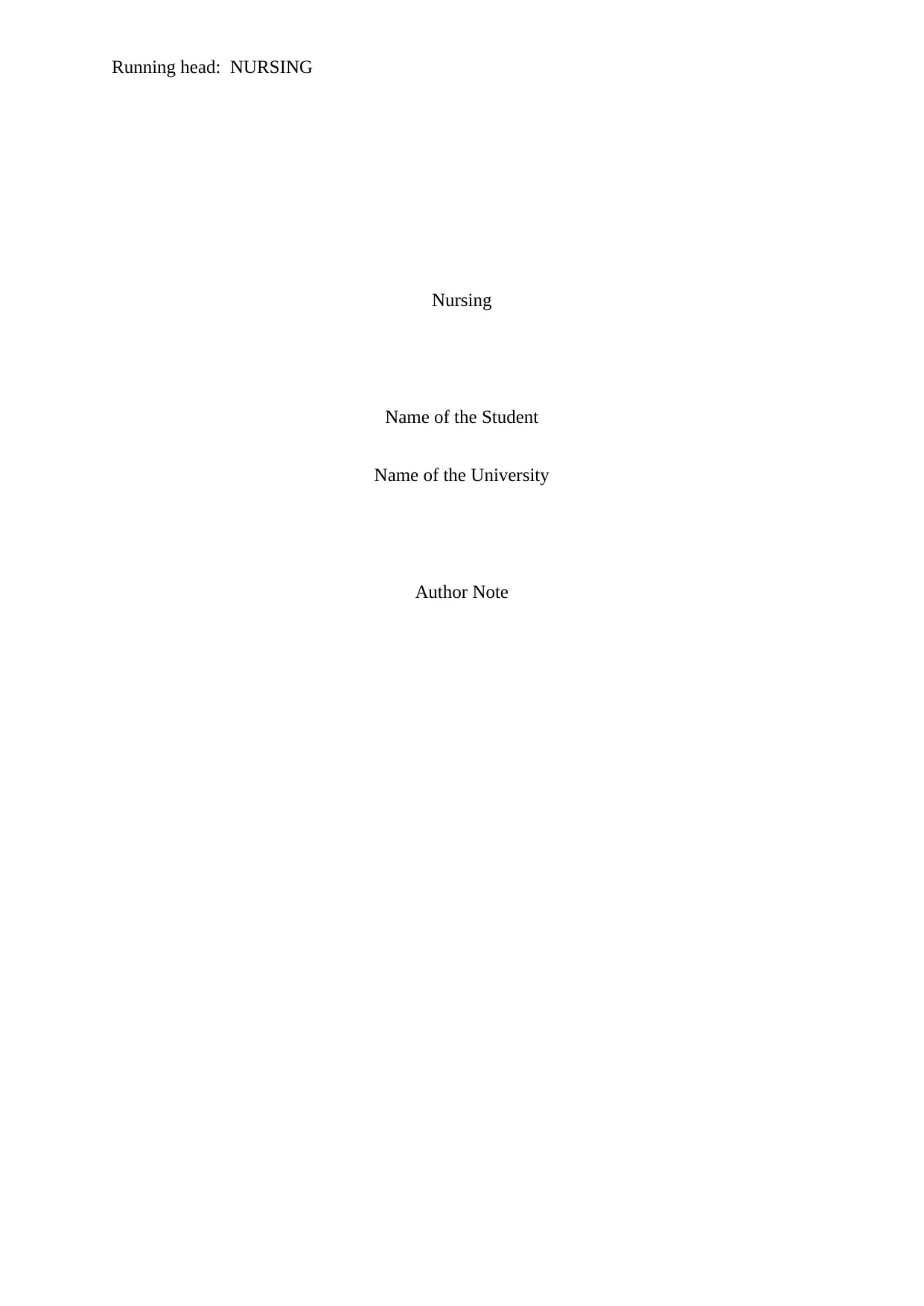
Running head: NURSING
Nursing
Name of the Student
Name of the University
Author Note
Nursing
Name of the Student
Name of the University
Author Note
Secure Best Marks with AI Grader
Need help grading? Try our AI Grader for instant feedback on your assignments.
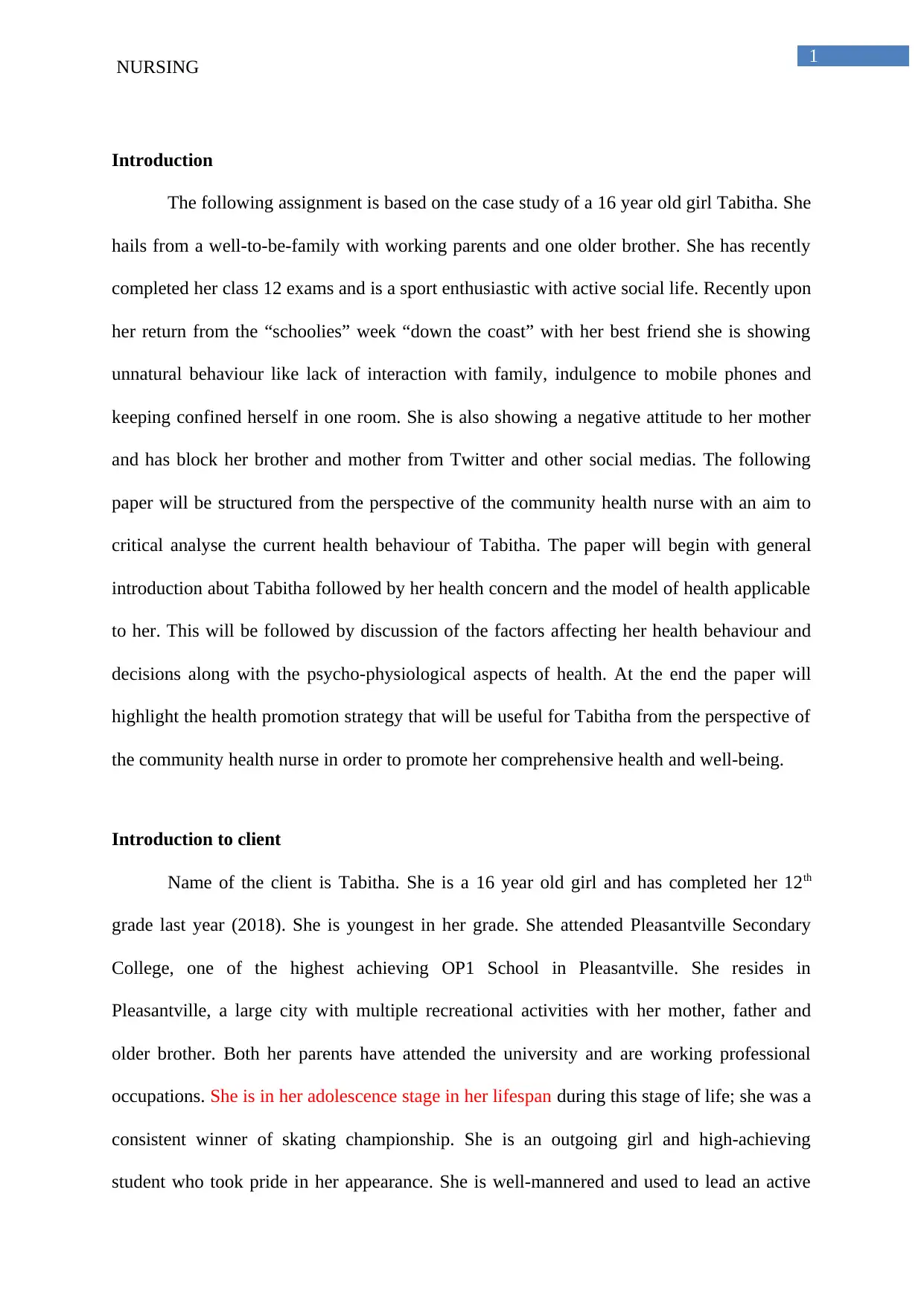
1
NURSING
Introduction
The following assignment is based on the case study of a 16 year old girl Tabitha. She
hails from a well-to-be-family with working parents and one older brother. She has recently
completed her class 12 exams and is a sport enthusiastic with active social life. Recently upon
her return from the “schoolies” week “down the coast” with her best friend she is showing
unnatural behaviour like lack of interaction with family, indulgence to mobile phones and
keeping confined herself in one room. She is also showing a negative attitude to her mother
and has block her brother and mother from Twitter and other social medias. The following
paper will be structured from the perspective of the community health nurse with an aim to
critical analyse the current health behaviour of Tabitha. The paper will begin with general
introduction about Tabitha followed by her health concern and the model of health applicable
to her. This will be followed by discussion of the factors affecting her health behaviour and
decisions along with the psycho-physiological aspects of health. At the end the paper will
highlight the health promotion strategy that will be useful for Tabitha from the perspective of
the community health nurse in order to promote her comprehensive health and well-being.
Introduction to client
Name of the client is Tabitha. She is a 16 year old girl and has completed her 12th
grade last year (2018). She is youngest in her grade. She attended Pleasantville Secondary
College, one of the highest achieving OP1 School in Pleasantville. She resides in
Pleasantville, a large city with multiple recreational activities with her mother, father and
older brother. Both her parents have attended the university and are working professional
occupations. She is in her adolescence stage in her lifespan during this stage of life; she was a
consistent winner of skating championship. She is an outgoing girl and high-achieving
student who took pride in her appearance. She is well-mannered and used to lead an active
NURSING
Introduction
The following assignment is based on the case study of a 16 year old girl Tabitha. She
hails from a well-to-be-family with working parents and one older brother. She has recently
completed her class 12 exams and is a sport enthusiastic with active social life. Recently upon
her return from the “schoolies” week “down the coast” with her best friend she is showing
unnatural behaviour like lack of interaction with family, indulgence to mobile phones and
keeping confined herself in one room. She is also showing a negative attitude to her mother
and has block her brother and mother from Twitter and other social medias. The following
paper will be structured from the perspective of the community health nurse with an aim to
critical analyse the current health behaviour of Tabitha. The paper will begin with general
introduction about Tabitha followed by her health concern and the model of health applicable
to her. This will be followed by discussion of the factors affecting her health behaviour and
decisions along with the psycho-physiological aspects of health. At the end the paper will
highlight the health promotion strategy that will be useful for Tabitha from the perspective of
the community health nurse in order to promote her comprehensive health and well-being.
Introduction to client
Name of the client is Tabitha. She is a 16 year old girl and has completed her 12th
grade last year (2018). She is youngest in her grade. She attended Pleasantville Secondary
College, one of the highest achieving OP1 School in Pleasantville. She resides in
Pleasantville, a large city with multiple recreational activities with her mother, father and
older brother. Both her parents have attended the university and are working professional
occupations. She is in her adolescence stage in her lifespan during this stage of life; she was a
consistent winner of skating championship. She is an outgoing girl and high-achieving
student who took pride in her appearance. She is well-mannered and used to lead an active
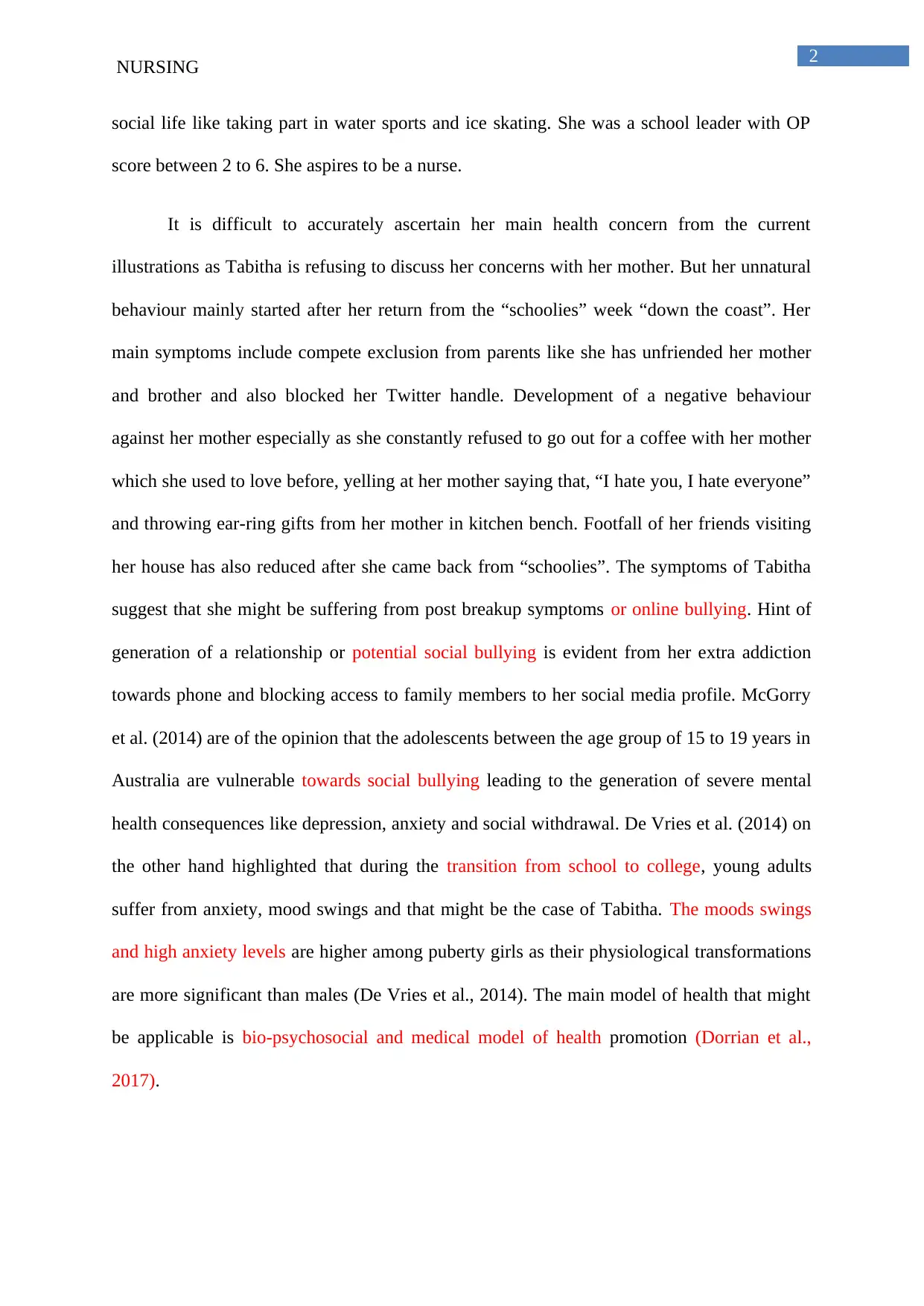
2
NURSING
social life like taking part in water sports and ice skating. She was a school leader with OP
score between 2 to 6. She aspires to be a nurse.
It is difficult to accurately ascertain her main health concern from the current
illustrations as Tabitha is refusing to discuss her concerns with her mother. But her unnatural
behaviour mainly started after her return from the “schoolies” week “down the coast”. Her
main symptoms include compete exclusion from parents like she has unfriended her mother
and brother and also blocked her Twitter handle. Development of a negative behaviour
against her mother especially as she constantly refused to go out for a coffee with her mother
which she used to love before, yelling at her mother saying that, “I hate you, I hate everyone”
and throwing ear-ring gifts from her mother in kitchen bench. Footfall of her friends visiting
her house has also reduced after she came back from “schoolies”. The symptoms of Tabitha
suggest that she might be suffering from post breakup symptoms or online bullying. Hint of
generation of a relationship or potential social bullying is evident from her extra addiction
towards phone and blocking access to family members to her social media profile. McGorry
et al. (2014) are of the opinion that the adolescents between the age group of 15 to 19 years in
Australia are vulnerable towards social bullying leading to the generation of severe mental
health consequences like depression, anxiety and social withdrawal. De Vries et al. (2014) on
the other hand highlighted that during the transition from school to college, young adults
suffer from anxiety, mood swings and that might be the case of Tabitha. The moods swings
and high anxiety levels are higher among puberty girls as their physiological transformations
are more significant than males (De Vries et al., 2014). The main model of health that might
be applicable is bio-psychosocial and medical model of health promotion (Dorrian et al.,
2017).
NURSING
social life like taking part in water sports and ice skating. She was a school leader with OP
score between 2 to 6. She aspires to be a nurse.
It is difficult to accurately ascertain her main health concern from the current
illustrations as Tabitha is refusing to discuss her concerns with her mother. But her unnatural
behaviour mainly started after her return from the “schoolies” week “down the coast”. Her
main symptoms include compete exclusion from parents like she has unfriended her mother
and brother and also blocked her Twitter handle. Development of a negative behaviour
against her mother especially as she constantly refused to go out for a coffee with her mother
which she used to love before, yelling at her mother saying that, “I hate you, I hate everyone”
and throwing ear-ring gifts from her mother in kitchen bench. Footfall of her friends visiting
her house has also reduced after she came back from “schoolies”. The symptoms of Tabitha
suggest that she might be suffering from post breakup symptoms or online bullying. Hint of
generation of a relationship or potential social bullying is evident from her extra addiction
towards phone and blocking access to family members to her social media profile. McGorry
et al. (2014) are of the opinion that the adolescents between the age group of 15 to 19 years in
Australia are vulnerable towards social bullying leading to the generation of severe mental
health consequences like depression, anxiety and social withdrawal. De Vries et al. (2014) on
the other hand highlighted that during the transition from school to college, young adults
suffer from anxiety, mood swings and that might be the case of Tabitha. The moods swings
and high anxiety levels are higher among puberty girls as their physiological transformations
are more significant than males (De Vries et al., 2014). The main model of health that might
be applicable is bio-psychosocial and medical model of health promotion (Dorrian et al.,
2017).
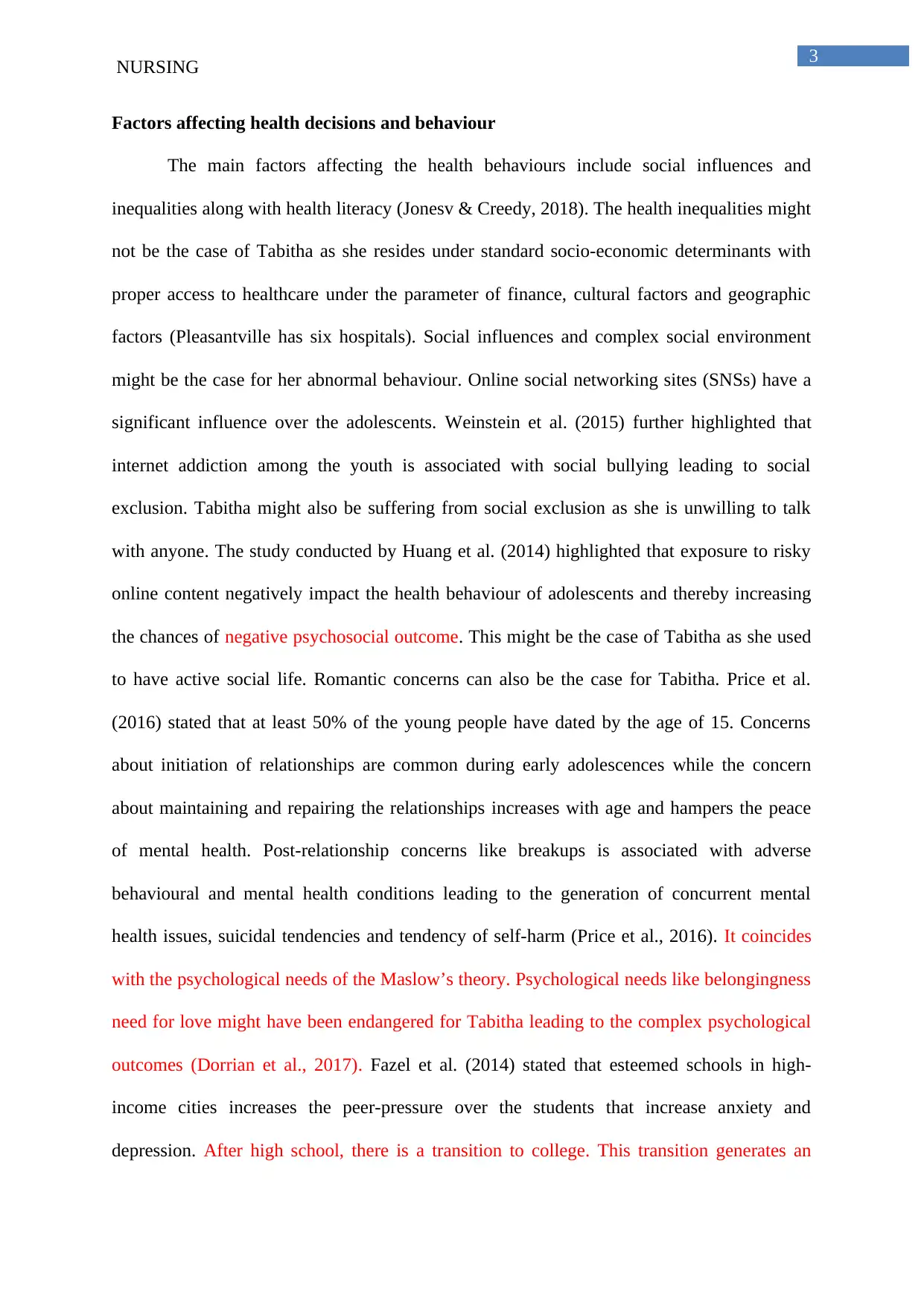
3
NURSING
Factors affecting health decisions and behaviour
The main factors affecting the health behaviours include social influences and
inequalities along with health literacy (Jonesv & Creedy, 2018). The health inequalities might
not be the case of Tabitha as she resides under standard socio-economic determinants with
proper access to healthcare under the parameter of finance, cultural factors and geographic
factors (Pleasantville has six hospitals). Social influences and complex social environment
might be the case for her abnormal behaviour. Online social networking sites (SNSs) have a
significant influence over the adolescents. Weinstein et al. (2015) further highlighted that
internet addiction among the youth is associated with social bullying leading to social
exclusion. Tabitha might also be suffering from social exclusion as she is unwilling to talk
with anyone. The study conducted by Huang et al. (2014) highlighted that exposure to risky
online content negatively impact the health behaviour of adolescents and thereby increasing
the chances of negative psychosocial outcome. This might be the case of Tabitha as she used
to have active social life. Romantic concerns can also be the case for Tabitha. Price et al.
(2016) stated that at least 50% of the young people have dated by the age of 15. Concerns
about initiation of relationships are common during early adolescences while the concern
about maintaining and repairing the relationships increases with age and hampers the peace
of mental health. Post-relationship concerns like breakups is associated with adverse
behavioural and mental health conditions leading to the generation of concurrent mental
health issues, suicidal tendencies and tendency of self-harm (Price et al., 2016). It coincides
with the psychological needs of the Maslow’s theory. Psychological needs like belongingness
need for love might have been endangered for Tabitha leading to the complex psychological
outcomes (Dorrian et al., 2017). Fazel et al. (2014) stated that esteemed schools in high-
income cities increases the peer-pressure over the students that increase anxiety and
depression. After high school, there is a transition to college. This transition generates an
NURSING
Factors affecting health decisions and behaviour
The main factors affecting the health behaviours include social influences and
inequalities along with health literacy (Jonesv & Creedy, 2018). The health inequalities might
not be the case of Tabitha as she resides under standard socio-economic determinants with
proper access to healthcare under the parameter of finance, cultural factors and geographic
factors (Pleasantville has six hospitals). Social influences and complex social environment
might be the case for her abnormal behaviour. Online social networking sites (SNSs) have a
significant influence over the adolescents. Weinstein et al. (2015) further highlighted that
internet addiction among the youth is associated with social bullying leading to social
exclusion. Tabitha might also be suffering from social exclusion as she is unwilling to talk
with anyone. The study conducted by Huang et al. (2014) highlighted that exposure to risky
online content negatively impact the health behaviour of adolescents and thereby increasing
the chances of negative psychosocial outcome. This might be the case of Tabitha as she used
to have active social life. Romantic concerns can also be the case for Tabitha. Price et al.
(2016) stated that at least 50% of the young people have dated by the age of 15. Concerns
about initiation of relationships are common during early adolescences while the concern
about maintaining and repairing the relationships increases with age and hampers the peace
of mental health. Post-relationship concerns like breakups is associated with adverse
behavioural and mental health conditions leading to the generation of concurrent mental
health issues, suicidal tendencies and tendency of self-harm (Price et al., 2016). It coincides
with the psychological needs of the Maslow’s theory. Psychological needs like belongingness
need for love might have been endangered for Tabitha leading to the complex psychological
outcomes (Dorrian et al., 2017). Fazel et al. (2014) stated that esteemed schools in high-
income cities increases the peer-pressure over the students that increase anxiety and
depression. After high school, there is a transition to college. This transition generates an
Secure Best Marks with AI Grader
Need help grading? Try our AI Grader for instant feedback on your assignments.
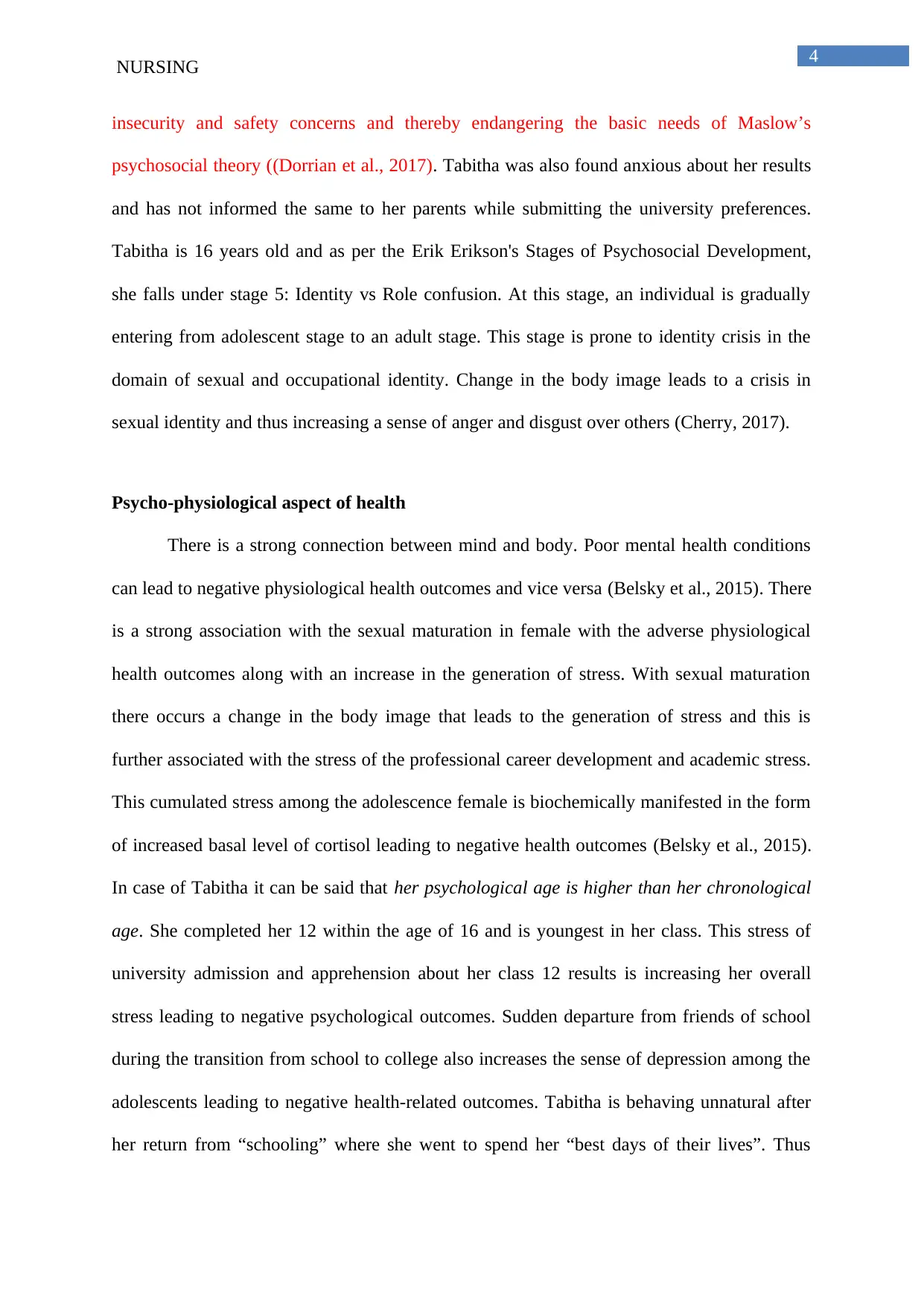
4
NURSING
insecurity and safety concerns and thereby endangering the basic needs of Maslow’s
psychosocial theory ((Dorrian et al., 2017). Tabitha was also found anxious about her results
and has not informed the same to her parents while submitting the university preferences.
Tabitha is 16 years old and as per the Erik Erikson's Stages of Psychosocial Development,
she falls under stage 5: Identity vs Role confusion. At this stage, an individual is gradually
entering from adolescent stage to an adult stage. This stage is prone to identity crisis in the
domain of sexual and occupational identity. Change in the body image leads to a crisis in
sexual identity and thus increasing a sense of anger and disgust over others (Cherry, 2017).
Psycho-physiological aspect of health
There is a strong connection between mind and body. Poor mental health conditions
can lead to negative physiological health outcomes and vice versa (Belsky et al., 2015). There
is a strong association with the sexual maturation in female with the adverse physiological
health outcomes along with an increase in the generation of stress. With sexual maturation
there occurs a change in the body image that leads to the generation of stress and this is
further associated with the stress of the professional career development and academic stress.
This cumulated stress among the adolescence female is biochemically manifested in the form
of increased basal level of cortisol leading to negative health outcomes (Belsky et al., 2015).
In case of Tabitha it can be said that her psychological age is higher than her chronological
age. She completed her 12 within the age of 16 and is youngest in her class. This stress of
university admission and apprehension about her class 12 results is increasing her overall
stress leading to negative psychological outcomes. Sudden departure from friends of school
during the transition from school to college also increases the sense of depression among the
adolescents leading to negative health-related outcomes. Tabitha is behaving unnatural after
her return from “schooling” where she went to spend her “best days of their lives”. Thus
NURSING
insecurity and safety concerns and thereby endangering the basic needs of Maslow’s
psychosocial theory ((Dorrian et al., 2017). Tabitha was also found anxious about her results
and has not informed the same to her parents while submitting the university preferences.
Tabitha is 16 years old and as per the Erik Erikson's Stages of Psychosocial Development,
she falls under stage 5: Identity vs Role confusion. At this stage, an individual is gradually
entering from adolescent stage to an adult stage. This stage is prone to identity crisis in the
domain of sexual and occupational identity. Change in the body image leads to a crisis in
sexual identity and thus increasing a sense of anger and disgust over others (Cherry, 2017).
Psycho-physiological aspect of health
There is a strong connection between mind and body. Poor mental health conditions
can lead to negative physiological health outcomes and vice versa (Belsky et al., 2015). There
is a strong association with the sexual maturation in female with the adverse physiological
health outcomes along with an increase in the generation of stress. With sexual maturation
there occurs a change in the body image that leads to the generation of stress and this is
further associated with the stress of the professional career development and academic stress.
This cumulated stress among the adolescence female is biochemically manifested in the form
of increased basal level of cortisol leading to negative health outcomes (Belsky et al., 2015).
In case of Tabitha it can be said that her psychological age is higher than her chronological
age. She completed her 12 within the age of 16 and is youngest in her class. This stress of
university admission and apprehension about her class 12 results is increasing her overall
stress leading to negative psychological outcomes. Sudden departure from friends of school
during the transition from school to college also increases the sense of depression among the
adolescents leading to negative health-related outcomes. Tabitha is behaving unnatural after
her return from “schooling” where she went to spend her “best days of their lives”. Thus
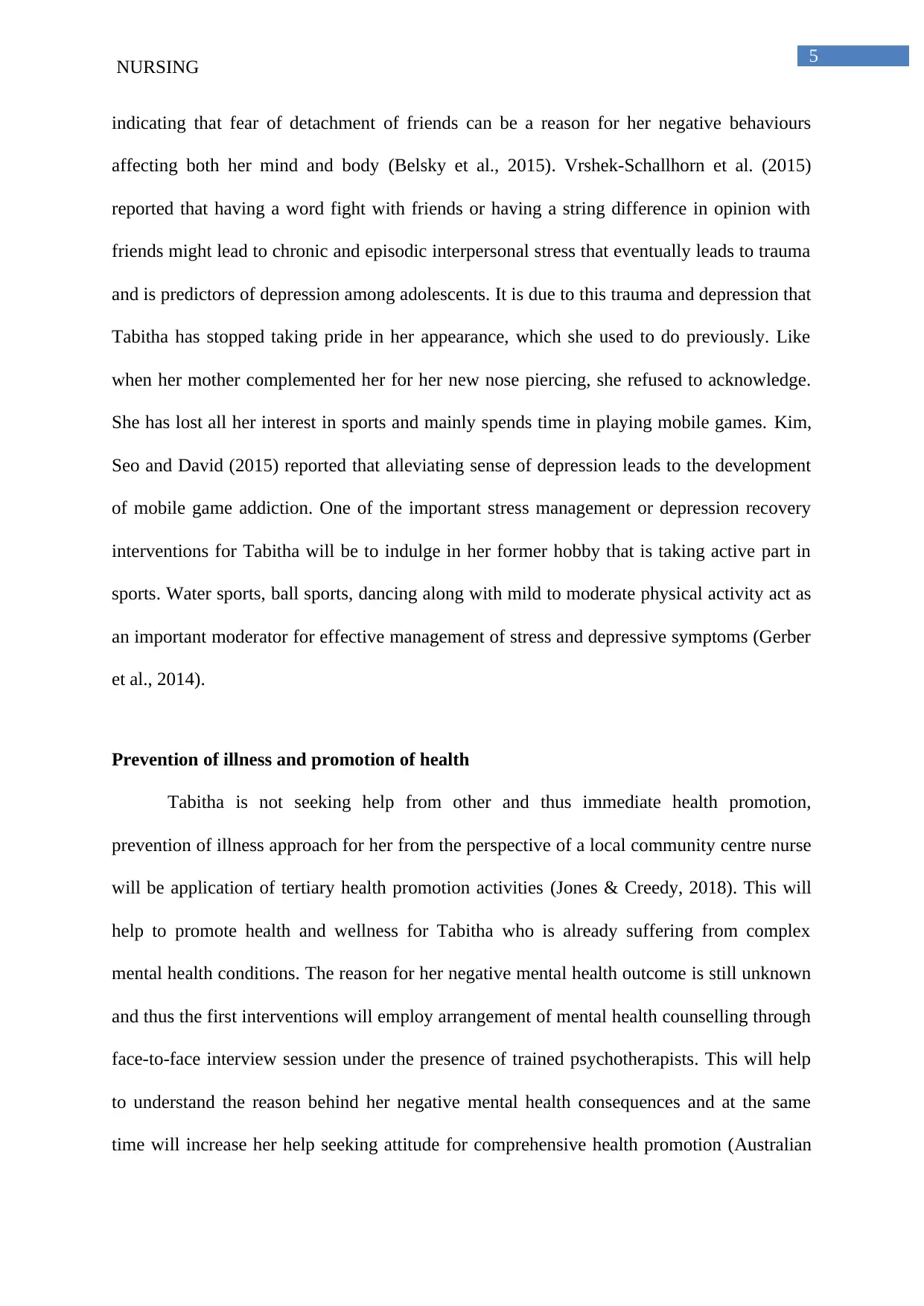
5
NURSING
indicating that fear of detachment of friends can be a reason for her negative behaviours
affecting both her mind and body (Belsky et al., 2015). Vrshek-Schallhorn et al. (2015)
reported that having a word fight with friends or having a string difference in opinion with
friends might lead to chronic and episodic interpersonal stress that eventually leads to trauma
and is predictors of depression among adolescents. It is due to this trauma and depression that
Tabitha has stopped taking pride in her appearance, which she used to do previously. Like
when her mother complemented her for her new nose piercing, she refused to acknowledge.
She has lost all her interest in sports and mainly spends time in playing mobile games. Kim,
Seo and David (2015) reported that alleviating sense of depression leads to the development
of mobile game addiction. One of the important stress management or depression recovery
interventions for Tabitha will be to indulge in her former hobby that is taking active part in
sports. Water sports, ball sports, dancing along with mild to moderate physical activity act as
an important moderator for effective management of stress and depressive symptoms (Gerber
et al., 2014).
Prevention of illness and promotion of health
Tabitha is not seeking help from other and thus immediate health promotion,
prevention of illness approach for her from the perspective of a local community centre nurse
will be application of tertiary health promotion activities (Jones & Creedy, 2018). This will
help to promote health and wellness for Tabitha who is already suffering from complex
mental health conditions. The reason for her negative mental health outcome is still unknown
and thus the first interventions will employ arrangement of mental health counselling through
face-to-face interview session under the presence of trained psychotherapists. This will help
to understand the reason behind her negative mental health consequences and at the same
time will increase her help seeking attitude for comprehensive health promotion (Australian
NURSING
indicating that fear of detachment of friends can be a reason for her negative behaviours
affecting both her mind and body (Belsky et al., 2015). Vrshek-Schallhorn et al. (2015)
reported that having a word fight with friends or having a string difference in opinion with
friends might lead to chronic and episodic interpersonal stress that eventually leads to trauma
and is predictors of depression among adolescents. It is due to this trauma and depression that
Tabitha has stopped taking pride in her appearance, which she used to do previously. Like
when her mother complemented her for her new nose piercing, she refused to acknowledge.
She has lost all her interest in sports and mainly spends time in playing mobile games. Kim,
Seo and David (2015) reported that alleviating sense of depression leads to the development
of mobile game addiction. One of the important stress management or depression recovery
interventions for Tabitha will be to indulge in her former hobby that is taking active part in
sports. Water sports, ball sports, dancing along with mild to moderate physical activity act as
an important moderator for effective management of stress and depressive symptoms (Gerber
et al., 2014).
Prevention of illness and promotion of health
Tabitha is not seeking help from other and thus immediate health promotion,
prevention of illness approach for her from the perspective of a local community centre nurse
will be application of tertiary health promotion activities (Jones & Creedy, 2018). This will
help to promote health and wellness for Tabitha who is already suffering from complex
mental health conditions. The reason for her negative mental health outcome is still unknown
and thus the first interventions will employ arrangement of mental health counselling through
face-to-face interview session under the presence of trained psychotherapists. This will help
to understand the reason behind her negative mental health consequences and at the same
time will increase her help seeking attitude for comprehensive health promotion (Australian
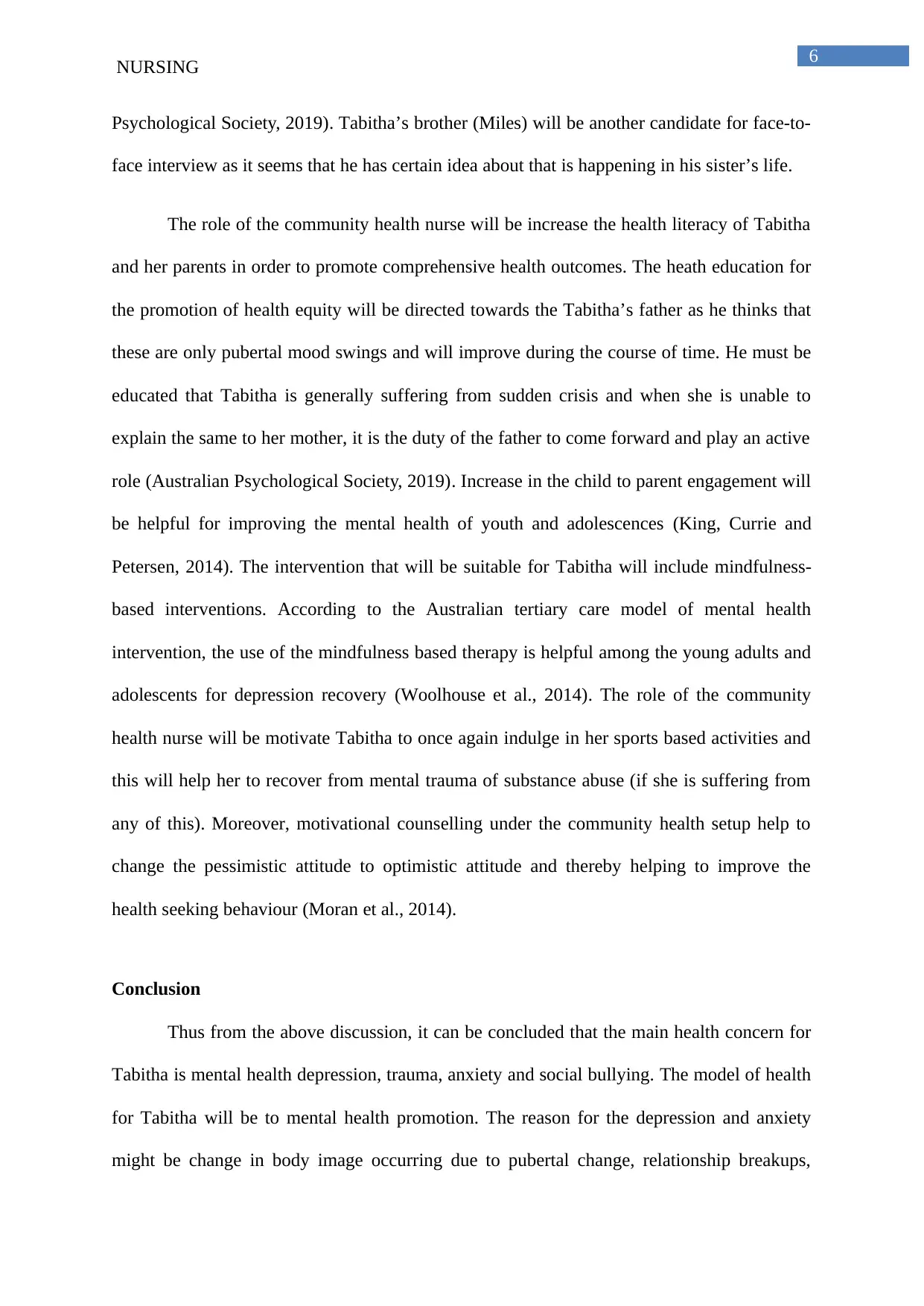
6
NURSING
Psychological Society, 2019). Tabitha’s brother (Miles) will be another candidate for face-to-
face interview as it seems that he has certain idea about that is happening in his sister’s life.
The role of the community health nurse will be increase the health literacy of Tabitha
and her parents in order to promote comprehensive health outcomes. The heath education for
the promotion of health equity will be directed towards the Tabitha’s father as he thinks that
these are only pubertal mood swings and will improve during the course of time. He must be
educated that Tabitha is generally suffering from sudden crisis and when she is unable to
explain the same to her mother, it is the duty of the father to come forward and play an active
role (Australian Psychological Society, 2019). Increase in the child to parent engagement will
be helpful for improving the mental health of youth and adolescences (King, Currie and
Petersen, 2014). The intervention that will be suitable for Tabitha will include mindfulness-
based interventions. According to the Australian tertiary care model of mental health
intervention, the use of the mindfulness based therapy is helpful among the young adults and
adolescents for depression recovery (Woolhouse et al., 2014). The role of the community
health nurse will be motivate Tabitha to once again indulge in her sports based activities and
this will help her to recover from mental trauma of substance abuse (if she is suffering from
any of this). Moreover, motivational counselling under the community health setup help to
change the pessimistic attitude to optimistic attitude and thereby helping to improve the
health seeking behaviour (Moran et al., 2014).
Conclusion
Thus from the above discussion, it can be concluded that the main health concern for
Tabitha is mental health depression, trauma, anxiety and social bullying. The model of health
for Tabitha will be to mental health promotion. The reason for the depression and anxiety
might be change in body image occurring due to pubertal change, relationship breakups,
NURSING
Psychological Society, 2019). Tabitha’s brother (Miles) will be another candidate for face-to-
face interview as it seems that he has certain idea about that is happening in his sister’s life.
The role of the community health nurse will be increase the health literacy of Tabitha
and her parents in order to promote comprehensive health outcomes. The heath education for
the promotion of health equity will be directed towards the Tabitha’s father as he thinks that
these are only pubertal mood swings and will improve during the course of time. He must be
educated that Tabitha is generally suffering from sudden crisis and when she is unable to
explain the same to her mother, it is the duty of the father to come forward and play an active
role (Australian Psychological Society, 2019). Increase in the child to parent engagement will
be helpful for improving the mental health of youth and adolescences (King, Currie and
Petersen, 2014). The intervention that will be suitable for Tabitha will include mindfulness-
based interventions. According to the Australian tertiary care model of mental health
intervention, the use of the mindfulness based therapy is helpful among the young adults and
adolescents for depression recovery (Woolhouse et al., 2014). The role of the community
health nurse will be motivate Tabitha to once again indulge in her sports based activities and
this will help her to recover from mental trauma of substance abuse (if she is suffering from
any of this). Moreover, motivational counselling under the community health setup help to
change the pessimistic attitude to optimistic attitude and thereby helping to improve the
health seeking behaviour (Moran et al., 2014).
Conclusion
Thus from the above discussion, it can be concluded that the main health concern for
Tabitha is mental health depression, trauma, anxiety and social bullying. The model of health
for Tabitha will be to mental health promotion. The reason for the depression and anxiety
might be change in body image occurring due to pubertal change, relationship breakups,
Paraphrase This Document
Need a fresh take? Get an instant paraphrase of this document with our AI Paraphraser
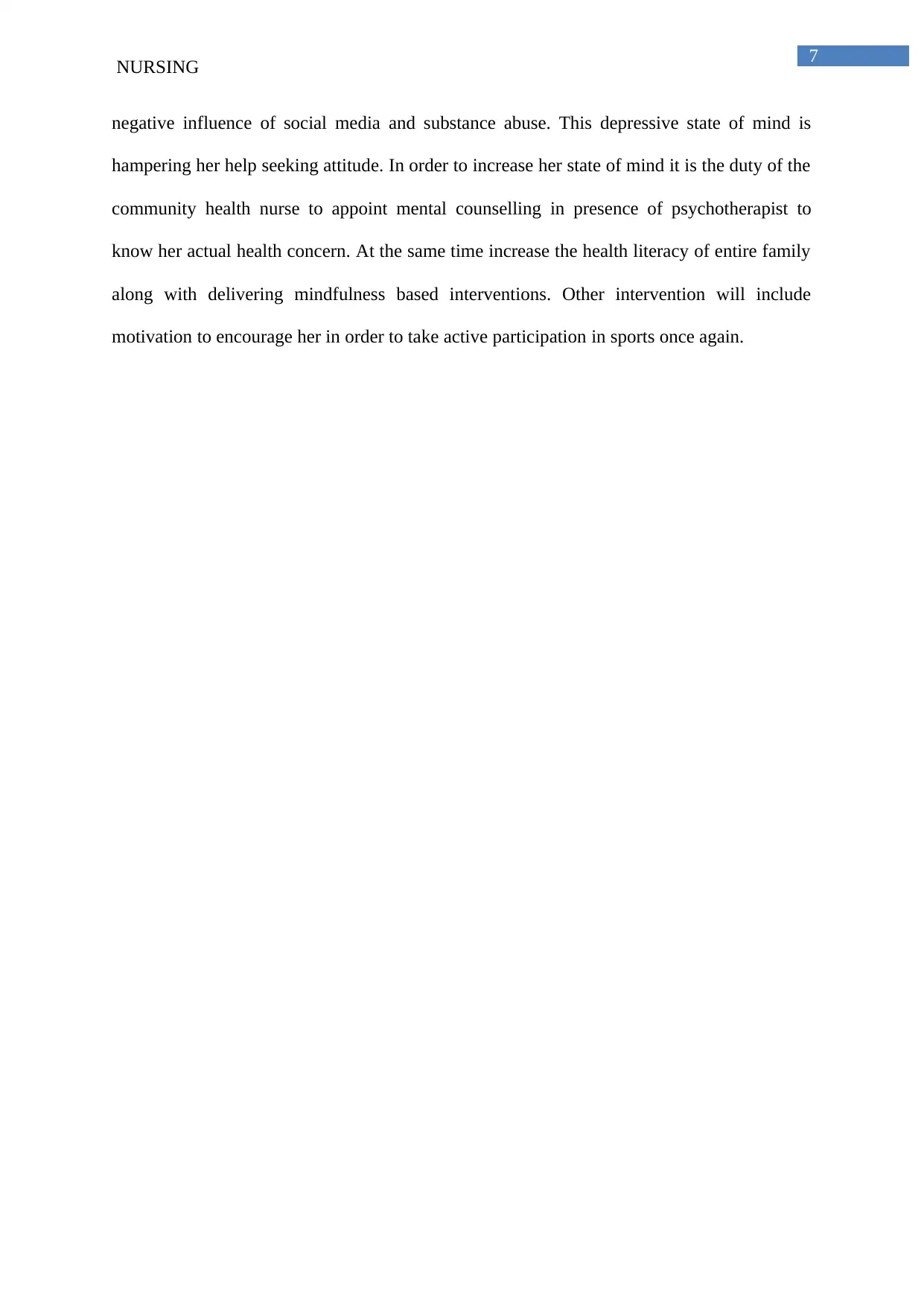
7
NURSING
negative influence of social media and substance abuse. This depressive state of mind is
hampering her help seeking attitude. In order to increase her state of mind it is the duty of the
community health nurse to appoint mental counselling in presence of psychotherapist to
know her actual health concern. At the same time increase the health literacy of entire family
along with delivering mindfulness based interventions. Other intervention will include
motivation to encourage her in order to take active participation in sports once again.
NURSING
negative influence of social media and substance abuse. This depressive state of mind is
hampering her help seeking attitude. In order to increase her state of mind it is the duty of the
community health nurse to appoint mental counselling in presence of psychotherapist to
know her actual health concern. At the same time increase the health literacy of entire family
along with delivering mindfulness based interventions. Other intervention will include
motivation to encourage her in order to take active participation in sports once again.
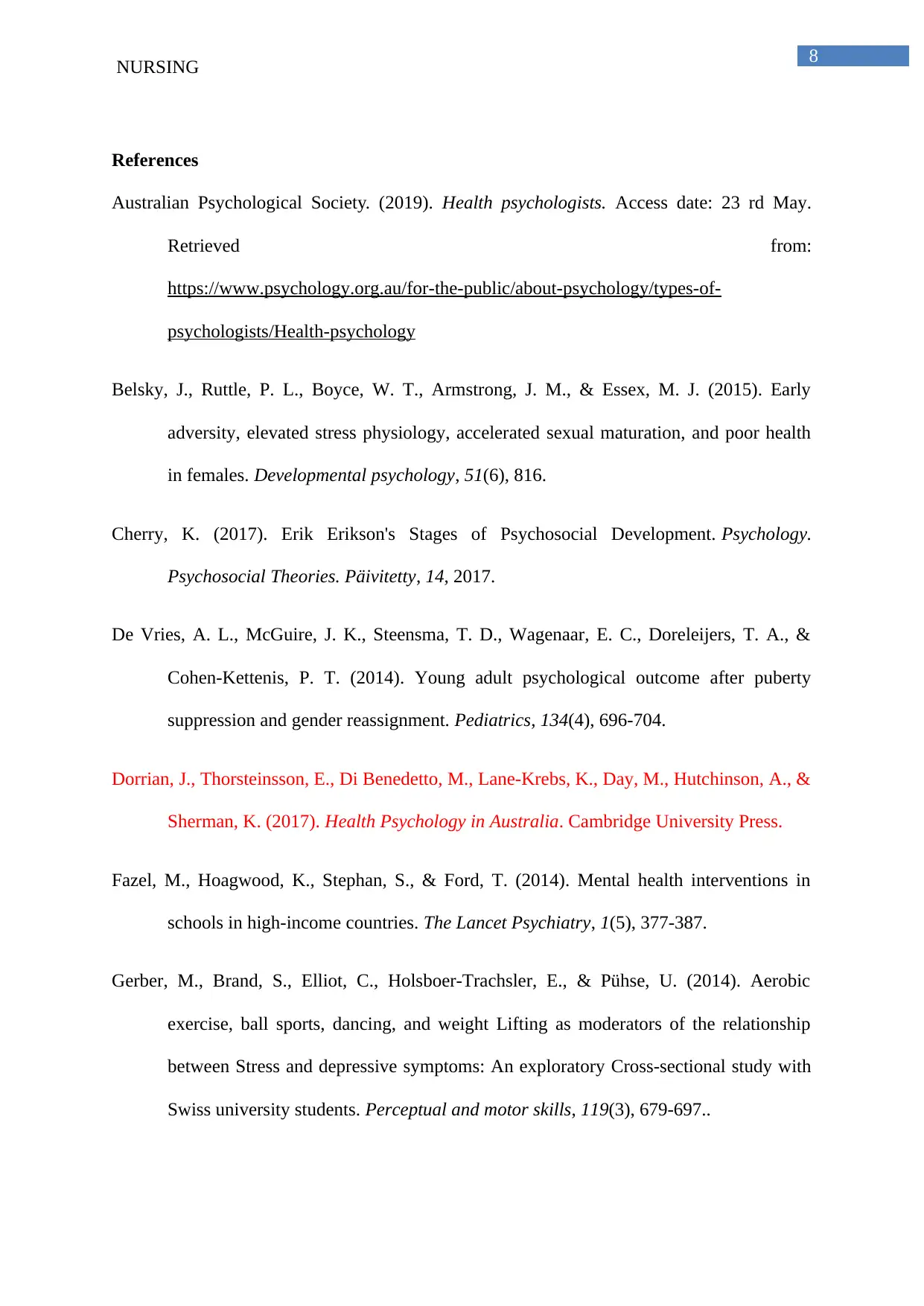
8
NURSING
References
Australian Psychological Society. (2019). Health psychologists. Access date: 23 rd May.
Retrieved from:
https://www.psychology.org.au/for-the-public/about-psychology/types-of-
psychologists/Health-psychology
Belsky, J., Ruttle, P. L., Boyce, W. T., Armstrong, J. M., & Essex, M. J. (2015). Early
adversity, elevated stress physiology, accelerated sexual maturation, and poor health
in females. Developmental psychology, 51(6), 816.
Cherry, K. (2017). Erik Erikson's Stages of Psychosocial Development. Psychology.
Psychosocial Theories. Päivitetty, 14, 2017.
De Vries, A. L., McGuire, J. K., Steensma, T. D., Wagenaar, E. C., Doreleijers, T. A., &
Cohen-Kettenis, P. T. (2014). Young adult psychological outcome after puberty
suppression and gender reassignment. Pediatrics, 134(4), 696-704.
Dorrian, J., Thorsteinsson, E., Di Benedetto, M., Lane-Krebs, K., Day, M., Hutchinson, A., &
Sherman, K. (2017). Health Psychology in Australia. Cambridge University Press.
Fazel, M., Hoagwood, K., Stephan, S., & Ford, T. (2014). Mental health interventions in
schools in high-income countries. The Lancet Psychiatry, 1(5), 377-387.
Gerber, M., Brand, S., Elliot, C., Holsboer-Trachsler, E., & Pühse, U. (2014). Aerobic
exercise, ball sports, dancing, and weight Lifting as moderators of the relationship
between Stress and depressive symptoms: An exploratory Cross-sectional study with
Swiss university students. Perceptual and motor skills, 119(3), 679-697..
NURSING
References
Australian Psychological Society. (2019). Health psychologists. Access date: 23 rd May.
Retrieved from:
https://www.psychology.org.au/for-the-public/about-psychology/types-of-
psychologists/Health-psychology
Belsky, J., Ruttle, P. L., Boyce, W. T., Armstrong, J. M., & Essex, M. J. (2015). Early
adversity, elevated stress physiology, accelerated sexual maturation, and poor health
in females. Developmental psychology, 51(6), 816.
Cherry, K. (2017). Erik Erikson's Stages of Psychosocial Development. Psychology.
Psychosocial Theories. Päivitetty, 14, 2017.
De Vries, A. L., McGuire, J. K., Steensma, T. D., Wagenaar, E. C., Doreleijers, T. A., &
Cohen-Kettenis, P. T. (2014). Young adult psychological outcome after puberty
suppression and gender reassignment. Pediatrics, 134(4), 696-704.
Dorrian, J., Thorsteinsson, E., Di Benedetto, M., Lane-Krebs, K., Day, M., Hutchinson, A., &
Sherman, K. (2017). Health Psychology in Australia. Cambridge University Press.
Fazel, M., Hoagwood, K., Stephan, S., & Ford, T. (2014). Mental health interventions in
schools in high-income countries. The Lancet Psychiatry, 1(5), 377-387.
Gerber, M., Brand, S., Elliot, C., Holsboer-Trachsler, E., & Pühse, U. (2014). Aerobic
exercise, ball sports, dancing, and weight Lifting as moderators of the relationship
between Stress and depressive symptoms: An exploratory Cross-sectional study with
Swiss university students. Perceptual and motor skills, 119(3), 679-697..
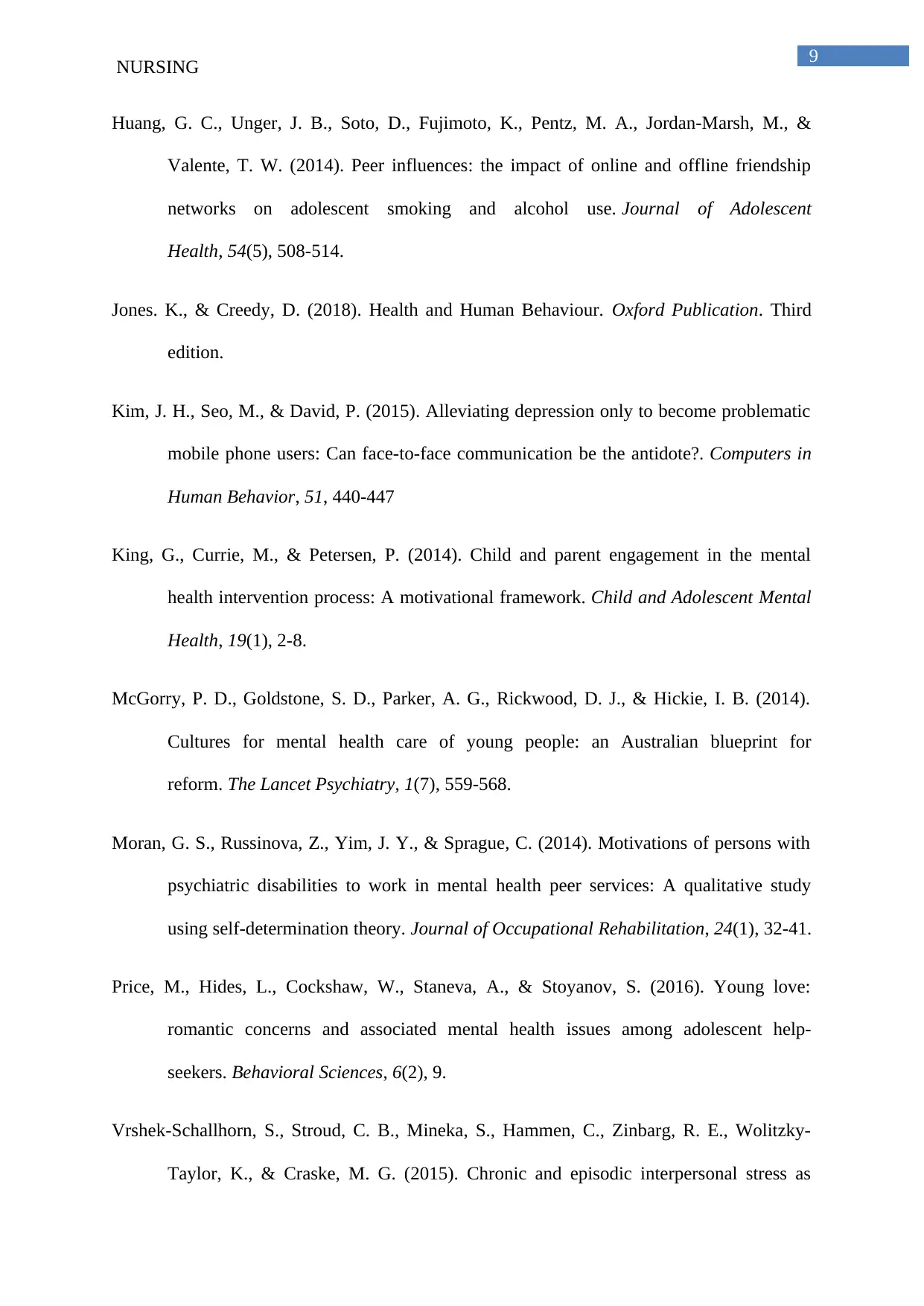
9
NURSING
Huang, G. C., Unger, J. B., Soto, D., Fujimoto, K., Pentz, M. A., Jordan-Marsh, M., &
Valente, T. W. (2014). Peer influences: the impact of online and offline friendship
networks on adolescent smoking and alcohol use. Journal of Adolescent
Health, 54(5), 508-514.
Jones. K., & Creedy, D. (2018). Health and Human Behaviour. Oxford Publication. Third
edition.
Kim, J. H., Seo, M., & David, P. (2015). Alleviating depression only to become problematic
mobile phone users: Can face-to-face communication be the antidote?. Computers in
Human Behavior, 51, 440-447
King, G., Currie, M., & Petersen, P. (2014). Child and parent engagement in the mental
health intervention process: A motivational framework. Child and Adolescent Mental
Health, 19(1), 2-8.
McGorry, P. D., Goldstone, S. D., Parker, A. G., Rickwood, D. J., & Hickie, I. B. (2014).
Cultures for mental health care of young people: an Australian blueprint for
reform. The Lancet Psychiatry, 1(7), 559-568.
Moran, G. S., Russinova, Z., Yim, J. Y., & Sprague, C. (2014). Motivations of persons with
psychiatric disabilities to work in mental health peer services: A qualitative study
using self-determination theory. Journal of Occupational Rehabilitation, 24(1), 32-41.
Price, M., Hides, L., Cockshaw, W., Staneva, A., & Stoyanov, S. (2016). Young love:
romantic concerns and associated mental health issues among adolescent help-
seekers. Behavioral Sciences, 6(2), 9.
Vrshek-Schallhorn, S., Stroud, C. B., Mineka, S., Hammen, C., Zinbarg, R. E., Wolitzky-
Taylor, K., & Craske, M. G. (2015). Chronic and episodic interpersonal stress as
NURSING
Huang, G. C., Unger, J. B., Soto, D., Fujimoto, K., Pentz, M. A., Jordan-Marsh, M., &
Valente, T. W. (2014). Peer influences: the impact of online and offline friendship
networks on adolescent smoking and alcohol use. Journal of Adolescent
Health, 54(5), 508-514.
Jones. K., & Creedy, D. (2018). Health and Human Behaviour. Oxford Publication. Third
edition.
Kim, J. H., Seo, M., & David, P. (2015). Alleviating depression only to become problematic
mobile phone users: Can face-to-face communication be the antidote?. Computers in
Human Behavior, 51, 440-447
King, G., Currie, M., & Petersen, P. (2014). Child and parent engagement in the mental
health intervention process: A motivational framework. Child and Adolescent Mental
Health, 19(1), 2-8.
McGorry, P. D., Goldstone, S. D., Parker, A. G., Rickwood, D. J., & Hickie, I. B. (2014).
Cultures for mental health care of young people: an Australian blueprint for
reform. The Lancet Psychiatry, 1(7), 559-568.
Moran, G. S., Russinova, Z., Yim, J. Y., & Sprague, C. (2014). Motivations of persons with
psychiatric disabilities to work in mental health peer services: A qualitative study
using self-determination theory. Journal of Occupational Rehabilitation, 24(1), 32-41.
Price, M., Hides, L., Cockshaw, W., Staneva, A., & Stoyanov, S. (2016). Young love:
romantic concerns and associated mental health issues among adolescent help-
seekers. Behavioral Sciences, 6(2), 9.
Vrshek-Schallhorn, S., Stroud, C. B., Mineka, S., Hammen, C., Zinbarg, R. E., Wolitzky-
Taylor, K., & Craske, M. G. (2015). Chronic and episodic interpersonal stress as
Secure Best Marks with AI Grader
Need help grading? Try our AI Grader for instant feedback on your assignments.
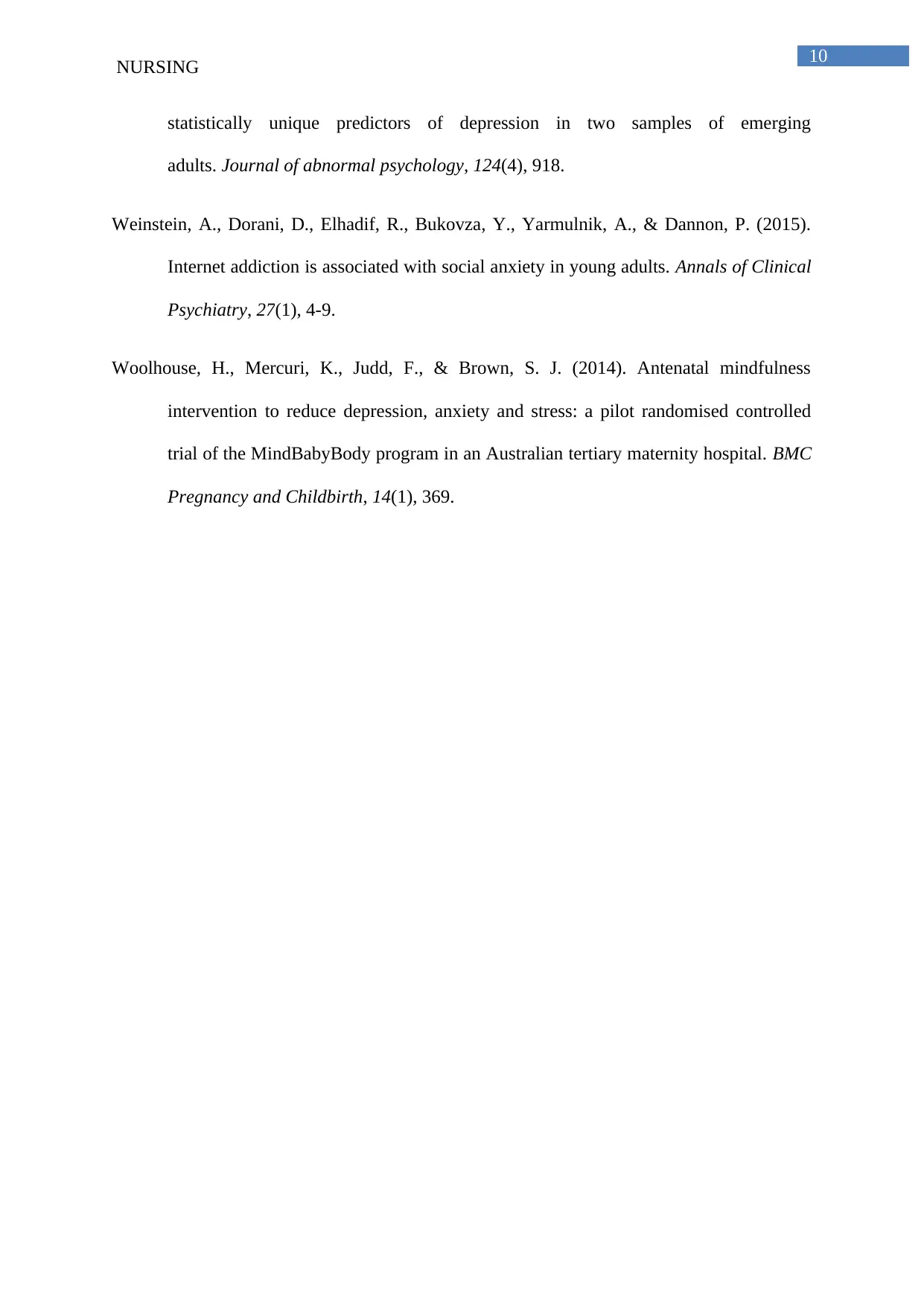
10
NURSING
statistically unique predictors of depression in two samples of emerging
adults. Journal of abnormal psychology, 124(4), 918.
Weinstein, A., Dorani, D., Elhadif, R., Bukovza, Y., Yarmulnik, A., & Dannon, P. (2015).
Internet addiction is associated with social anxiety in young adults. Annals of Clinical
Psychiatry, 27(1), 4-9.
Woolhouse, H., Mercuri, K., Judd, F., & Brown, S. J. (2014). Antenatal mindfulness
intervention to reduce depression, anxiety and stress: a pilot randomised controlled
trial of the MindBabyBody program in an Australian tertiary maternity hospital. BMC
Pregnancy and Childbirth, 14(1), 369.
NURSING
statistically unique predictors of depression in two samples of emerging
adults. Journal of abnormal psychology, 124(4), 918.
Weinstein, A., Dorani, D., Elhadif, R., Bukovza, Y., Yarmulnik, A., & Dannon, P. (2015).
Internet addiction is associated with social anxiety in young adults. Annals of Clinical
Psychiatry, 27(1), 4-9.
Woolhouse, H., Mercuri, K., Judd, F., & Brown, S. J. (2014). Antenatal mindfulness
intervention to reduce depression, anxiety and stress: a pilot randomised controlled
trial of the MindBabyBody program in an Australian tertiary maternity hospital. BMC
Pregnancy and Childbirth, 14(1), 369.
1 out of 11
Your All-in-One AI-Powered Toolkit for Academic Success.
+13062052269
info@desklib.com
Available 24*7 on WhatsApp / Email
![[object Object]](/_next/static/media/star-bottom.7253800d.svg)
Unlock your academic potential
© 2024 | Zucol Services PVT LTD | All rights reserved.